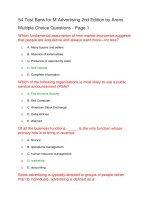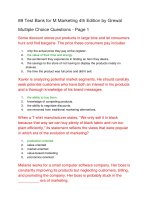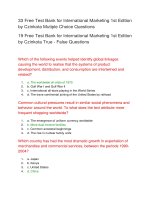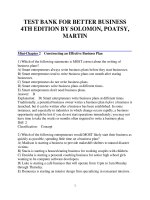Test bank for international business 13th edition by daniels
Bạn đang xem bản rút gọn của tài liệu. Xem và tải ngay bản đầy đủ của tài liệu tại đây (170.22 KB, 54 trang )
Test Bank for International Business 13th
Edition by Daniels
Chapter 2 The Cultural Environments Facing Business
Link download full:
/>dition-by-daniels
1) ________ consists of specific learned norms based on attitudes, values, and
beliefs of a group of people.
A) Ethnology
B) Civilization
C) Culture
D) Doctrine
Answer: C
Diff: 1 Page Ref: 49
Skill: Concept
Objective: STUDY QUESTION 2.1: Define and explain culture, cultural group
membership, and cultural diversity.
AACSB: Multicultural and Diversity
2) Which of the following is NOT true about cultural diversity?
A) Cultural diversity refers to individuals' diverse cultural memberships, such as age
and ethnicity groups.
B) Companies may gain competitive advantages by bringing together people of
diverse backgrounds.
C) Cultural diversity may help a company gain deeper knowledge about products
and services.
D) The process of bringing people of different national cultures together is often
difficult.
Answer: A
Diff: 2 Page Ref: 49
Skill: Concept
Objective: STUDY QUESTION 2.1: Define and explain culture, cultural group
membership, and cultural diversity.
AACSB: Multicultural and Diversity
3) Because people can be grouped in many ways, such as on the basis of nationality,
ethnicity, religion, profession, and income level, ________.
A) they live in a state of cultural collision
B) the study of national cultures can tell us little about expected behaviors
1
C) identity crises make lives chaotic
D) people have more than one cultural group membership
Answer: D
Diff: 1 Page Ref: 49
Skill: Concept
Objective: STUDY QUESTION 2.1: Define and explain culture, cultural group
membership, and cultural diversity.
AACSB: Multicultural and Diversity
2
4) When divergent cultures come in contact, ________ occurs.
A) power distance
B) culture shock
C) cultural collision
D) group membership
Answer: C
Diff: 1 Page Ref: 49
Skill: Concept
Objective: STUDY QUESTION 2.1: Define and explain culture, cultural group
membership, and cultural diversity.
AACSB: Multicultural and Diversity
5) Which of the following describes one of the conditions under which the major
problems of cultural collision arise in international business?
A) when a company's employees encounter distress because of difficulty in
accepting or adjusting to foreign behaviors
B) when employees disagree on the style of art for decorating the office
C) when local people have no expectation that foreigners should adjust to their
culture
D) when companies understand and adjust to the national cultures in which they do
business
Answer: A
Diff: 1 Page Ref: 49
Skill: Concept
Objective: STUDY QUESTION 2.1: Define and explain culture, cultural group
membership, and cultural diversity.
AACSB: Multicultural and Diversity
6) Which of the following is the most accurate statement about culture?
A) Cultural variables can easily be isolated from other factors such as economic and
political conditions.
B) We generally expect people from another culture to behave differently than we
do.
C) Although most cultural variables are universal, the forms these variables take
differ from culture to culture.
D) Within a culture, everyone responds to particular cultural variables the same way.
Answer: C
Diff: 2 Page Ref: 50
Skill: Concept
Objective: STUDY QUESTION 2.2: Why is awareness of cultural variables
important in international business? What are methods and problems in building
3
cultural awareness?
AACSB: Multicultural and Diversity
4
7) Businesspeople seeking to understand more about another culture in order to
successfully conduct business within that culture would be best advised to do which
of the following?
A) observe and emulate the behavior of people who have gained respect and
confidence within that cultural environment
B) rely on stereotypes, which are often based on averages, to gain an understanding
of the culture
C) avoid research on the culture in order to avoid developing unwarranted
stereotypes and prejudices
D) memorize the cultural variations they can expect to encounter while within that
cultural environment
Answer: A
Diff: 2 Page Ref: 50
Skill: Concept
Objective: STUDY QUESTION 2.2: Why is awareness of cultural variables
important in international business? What are methods and problems in building
cultural awareness?
AACSB: Multicultural and Diversity
8) Which of the following is a common shortcoming of studies examining culture in
different countries and regions?
A) Cultures are static, tending not to evolve much over periods of time. This tempts
researchers to draw conclusions from old data.
B) It is impossible to compare countries because of differences in the form of data
collected.
C) People are almost always reluctant to complain about their own cultures, so they
present only positive opinions to researchers.
D) Responses are reported in averages, which can lead to a belief in unrealistic
stereotypes.
Answer: D
Diff: 2 Page Ref: 51
Skill: Concept
Objective: STUDY QUESTION 2.2: Why is awareness of cultural variables
important in international business? What are methods and problems in building
cultural awareness?
AACSB: Multicultural and Diversity
9) The nation offers a workable reference for studying cultural differences because
________.
A) a nation contains only one distinct culture
B) similarity among people is both a cause and effect of national boundaries
5
C) the commonality of language within a nation eases the process of conducting
surveys
D) different groups within the same country always have more in common with each
other than with groups in other countries
Answer: B
Diff: 2 Page Ref: 51
Skill: Concept
Objective: STUDY QUESTION 2.3: What are the advantages and shortcomings of
using the nation as a point of reference for a culture?
AACSB: Multicultural and Diversity
6
10) A problem of using the nation as a reference point for culture is that ________.
A) nations fail to mediate the different interests within their boundaries
B) self-stereotypes tend to fall along national lines
C) such an approach tends to be polycentric
D) variations tend to be great within a country
Answer: D
Diff: 2 Page Ref: 52
Skill: Concept
Objective: STUDY QUESTION 2.3: What are the advantages and shortcomings of
using the nation as a point of reference for a culture?
AACSB: Multicultural and Diversity
11) Because certain cultural attributes can link groups from different nations more
closely than groups within a given nation, international businesspeople ________.
A) must be careful to compare relevant groups when comparing nations
B) should assume that there are few significant cultural differences among nations
C) should adopt universal operating methods
D) must avoid cultural imperialism
Answer: A
Diff: 2 Page Ref: 52
Skill: Concept
Objective: STUDY QUESTION 2.3: What are the advantages and shortcomings of
using the nation as a point of reference for a culture?
AACSB: Multicultural and Diversity
12) It is most accurate to say that within a nation's borders, people largely share such
essential attributes as ________ and ________.
A) work attitudes; religion
B) values; language
C) levels of education; ethnicity
D) lifestyles; social classes
Answer: B
Diff: 2 Page Ref: 51
Skill: Concept
Objective: STUDY QUESTION 2.3: What are the advantages and shortcomings of
using the nation as a point of reference for a culture?
AACSB: Multicultural and Diversity
7
13) Most people's basic value system is ________.
A) inborn
B) changed in adulthood through imposition
C) affected primarily by teenage peer pressure
D) fairly firmly in place at a young age
Answer: D
Diff: 2 Page Ref: 52
Skill: Concept
Objective: STUDY QUESTION 2.4: What factors influence cultural stability and
cultural change?
AACSB: Multicultural and Diversity
14) Contact among countries brings about cultural change, a process called
________.
A) cultural collision
B) cultural imperialism
C) cultural diffusion
D) creolization
Answer: C
Diff: 2 Page Ref: 52
Skill: Concept
Objective: STUDY QUESTION 2.4: What factors influence cultural stability and
cultural change?
AACSB: Multicultural and Diversity
15) Creolization refers to ________.
A) government efforts to maintain a distinct cultural identity
B) the process of mixing elements of an outside culture with those of a national
culture
C) the use of stereotypes to describe a culture
D) changes as cultures evolve over time
Answer: B
Diff: 2 Page Ref: 52
Skill: Concept
Objective: STUDY QUESTION 2.4: What factors influence cultural stability and
cultural change?
AACSB: Multicultural and Diversity
16) Cultural change imposed by an alien culture is called ________.
A) ethnocentricity
B) cultural imperialism
8
C) collectivism
D) creolization
Answer: B
Diff: 1 Page Ref: 52
Skill: Concept
Objective: STUDY QUESTION 2.4: What factors influence cultural stability and
cultural change?
AACSB: Multicultural and Diversity
17) Which of the following languages has the most native speakers?
A) English
B) Mandarin
C) Spanish
D) Hindi
Answer: B
Diff: 2 Page Ref: 55
Skill: Concept
Objective: STUDY QUESTION 2.5: Why are some languages (Which are they?)
more important than others? How/why might this change in the future?
AACSB: Multicultural and Diversity
18) ________ peoples account for the largest percentage of global production.
A) English-speaking
B) Mandarin-speaking
C) French-speaking
D) Spanish-speaking
Answer: A
Diff: 2 Page Ref: 53, 55
Skill: Concept
Objective: STUDY QUESTION 2.5: Why are some languages (Which are they?)
more important than others? How/why might this change in the future?
AACSB: Multicultural and Diversity
19) All of the following are true regarding English being the world's most common
second language EXCEPT which one?
A) The largest portion of global output is in English-speaking countries.
B) A large portion of MNEs are headquartered in English-speaking countries.
C) The large number of countries where English is official makes it the most spoken
first language.
D) The American media is influential worldwide.
Answer: C
9
Diff: 1 Page Ref: 55
Skill: Concept
Objective: STUDY QUESTION 2.5: Why are some languages (Which are they?)
more important than others? How/why might this change in the future?
AACSB: Multicultural and Diversity
10
20) Although English is referred to as the "international language of
business,"________.
A) it is less frequently used than French in international business
B) there is a growing disagreement over which version of English to use, e.g. British,
American, or Australian
C) companies headquartered outside English-speaking countries all use their official
language as their operating language
D) monolingual English speakers may experience more difficulty in the future in
communicating on a worldwide basis
Answer: D
Diff: 2 Page Ref: 54
Skill: Concept
Objective: STUDY QUESTION 2.5: Why are some languages (Which are they?)
more important than others? How/why might this change in the future?
AACSB: Multicultural and Diversity
21) International businesspeople need to understand social stratification systems
where they do business because ________.
A) such systems reflect the willingness of the local society to accept product
innovations
B) such systems indicate who people in a given culture will respect more
C) the high similarity among countries lets companies effectively use uniform hiring
and promotion practices globally
D) what is an ascribed group membership in one country is an acquired one in
another
Answer: B
Diff: 2 Page Ref: 56
Skill: Concept
Objective: STUDY QUESTION 2.6: What are major ways in which societies rank
people? What social stratification systems exist? Why is an understanding of social
stratification important in international business?
AACSB: Multicultural and Diversity
22) Which of the following is an example of an acquired group membership?
A) national origin
B) religion
C) gender
D) race
Answer: B
Diff: 2 Page Ref: 57
Skill: Concept
11
Objective: STUDY QUESTION 2.6: What are major ways in which societies rank
people? What social stratification systems exist? Why is an understanding of social
stratification important in international business?
AACSB: Multicultural and Diversity
12
23) Internationally, how does a person's competence affect his or her eligibility for
employment and promotion?
A) Competence is more important for hiring than for promotion.
B) Competence is more important in family-owned companies.
C) National norms differ.
D) Unless MNEs hire and promote abroad on the basis of competence, they meet
resistance to new management practices.
Answer: C
Diff: 2 Page Ref: 58
Skill: Concept
Objective: STUDY QUESTION 2.6: What are major ways in which societies rank
people? What social stratification systems exist? Why is an understanding of social
stratification important in international business?
AACSB: Multicultural and Diversity
24) The more closed a society is, the more important ________ group membership
is.
A) acquired
B) age-based
C) education
D) ascribed
Answer: D
Diff: 2 Page Ref: 58
Skill: Concept
Objective: STUDY QUESTION 2.6: What are major ways in which societies rank
people? What social stratification systems exist? Why is an understanding of social
stratification important in international business?
AACSB: Multicultural and Diversity
25) There is a strong correlation between the intensity of religious belief (regardless
of the specific system) and ________.
A) the desire to take productivity gains in the form of more income rather than
leisure
B) adherence to attributes that lead to economic growth, such as obeying laws and
being thrifty
C) the belief that material success is related to salvation
D) the degree of ethnocentrism exhibited in a culture
Answer: B
Diff: 2 Page Ref: 60
Skill: Concept
Objective: STUDY QUESTION 2.7: Describe the major theories that explain why
13
work motivation may differ from one country to another.
AACSB: Multicultural and Diversity
14
26) According to the theory of success and reward expectation, the greatest
enthusiasm for work generally occurs when there is a ________ likelihood of
success combined with a ________ reward for success compared to the reward for
failure.
A) high; high
B) high; low
C) low; high
D) low; low
Answer: C
Diff: 2 Page Ref: 61
Skill: Concept
Objective: STUDY QUESTION 2.7: Describe the major theories that explain why
work motivation may differ from one country to another.
27) A country in which the norm is a money-and-things orientation and a belief that
it's better to "live to work" than to "work to live" is most accurately characterized as
a ________ culture.
A) high masculinity
B) Protestant ethic
C) non-fatalistic
D) self-actualization
Answer: A
Diff: 2 Page Ref: 61
Skill: Concept
Objective: STUDY QUESTION 2.7: Describe the major theories that explain why
work motivation may differ from one country to another.
AACSB: Multicultural and Diversity
28) Based on the hierarchy-of-needs theory, in which of the following would
fulfillment of lower-order needs be the best motivator?
A) wealthy countries
B) Protestant countries
C) high femininity countries
D) very poor countries
Answer: D
Diff: 2 Page Ref: 61
Skill: Concept
Objective: STUDY QUESTION 2.7: Describe the major theories that explain why
work motivation may differ from one country to another.
AACSB: Multicultural and Diversity
15
29) People generally prefer little consultation between superiors and subordinates in
cultures where ________ is high.
A) power distance
B) fatalism
C) individualism
D) masculinity
Answer: A
Diff: 2 Page Ref: 63
Skill: Concept
Objective: STUDY QUESTION 2.8: Describe the relationship preferences
explained by power distance and individualism versus collectivism.
AACSB: Multicultural and Diversity
30) Which of the following is characterized by low dependence on an organization
and a desire for personal time, freedom, and challenges?
A) collectivism
B) democracy
C) individualism
D) anarchy
Answer: C
Diff: 1 Page Ref: 63
Skill: Concept
Objective: STUDY QUESTION 2.8: Describe the relationship preferences
explained by power distance and individualism versus collectivism.
AACSB: Multicultural and Diversity
31) In a country characterized as a high collectivist culture, ________.
A) workers generally dislike team-based work systems
B) workers are best motivated through fulfillment of self-actualization needs
C) there is little uncertainty avoidance
D) the collectivism may be present in kinship arrangements, but not in the workplace
Answer: D
Diff: 2 Page Ref: 63
Skill: Concept
Objective: STUDY QUESTION 2.8: Describe the relationship preferences
explained by power distance and individualism versus collectivism.
AACSB: Multicultural and Diversity
16
32) Safe work environments motivate ________; challenges motivate ________.
A) individualists; collectivists
B) collectivists; individualists
C) non-fatalists; fatalists
D) materialists; non-materialists
Answer: B
Diff: 2 Page Ref: 63
Skill: Concept
Objective: STUDY QUESTION 2.8: Describe the relationship preferences
explained by power distance and individualism versus collectivism.
AACSB: Multicultural and Diversity
33) Superiors may need to be more precise in their directions to subordinates when
________.
A) the company has a philosophy of geocentrism
B) the society believes age is equated with wisdom
C) power distance is low
D) uncertainty avoidance is high
Answer: D
Diff: 2 Page Ref: 64
Skill: Concept
Objective: STUDY QUESTION 2.9: What cultural factors help to explain
risk-taking behavior? How do differences affect business?
AACSB: Multicultural and Diversity
34) In societies where trust is high, ________.
A) people tend to be more future-oriented
B) the cost of doing business tends to be lower
C) people tend to be fatalistic
D) family businesses are dominant
Answer: B
Diff: 2 Page Ref: 64
Skill: Concept
Objective: STUDY QUESTION 2.9: What cultural factors help to explain
risk-taking behavior? How do differences affect business?
AACSB: Multicultural and Diversity
17
35) Companies may be able to better motivate workers through delayed
compensation, such as retirement programs, in a society characterized by ________.
A) low uncertainty avoidance
B) high trust
C) high future orientation
D) high masculinity
Answer: C
Diff: 2 Page Ref: 64
Skill: Concept
Objective: STUDY QUESTION 2.9: What cultural factors help to explain
risk-taking behavior? How do differences affect business?
AACSB: Multicultural and Diversity
36) Societies in which people are willing to work hard and to blame and reward
themselves for outcomes are most accurately characterized by a belief in ________.
A) self-determination
B) fatalism
C) collectivism
D) low power distance
Answer: A
Diff: 2 Page Ref: 64
Skill: Concept
Objective: STUDY QUESTION 2.9: What cultural factors help to explain
risk-taking behavior? How do differences affect business?
AACSB: Multicultural and Diversity
37) In a(n) ________ culture, people tend to regard seemingly peripheral
information as pertinent to decision making and infer meanings from things that
people say either indirectly or casually.
A) pragmatist
B) idealist
C) fatalistic
D) high-context
Answer: D
Diff: 1 Page Ref: 65
Skill: Concept
Objective: STUDY QUESTION 2.10: Explain the concepts of low-context versus
high-context cultures, monochronic versus polychronic cultures, and idealistic
versus pragmatist cultures.
AACSB: Multicultural and Diversity
18
38) A culture in which people prefer to finish one task before starting another is most
accurately characterized as which of the following?
A) low-context
B) monochronic
C) pragmatist
D) high power-distance
Answer: B
Diff: 1 Page Ref: 65
Skill: Concept
Objective: STUDY QUESTION 2.10: Explain the concepts of low-context versus
high-context cultures, monochronic versus polychronic cultures, and idealistic
versus pragmatist cultures.
AACSB: Multicultural and Diversity
39) A culture that prefers to first settle principles rather than small issues is most
accurately characterized as ________.
A) idealist
B) polychronic
C) high-context
D) pragmatist
Answer: A
Diff: 1 Page Ref: 65
Skill: Concept
Objective: STUDY QUESTION 2.10: Explain the concepts of low-context versus
high-context cultures, monochronic versus polychronic cultures, and idealistic
versus pragmatist cultures.
AACSB: Multicultural and Diversity
40) The attempt to resolve small issues before principles is a characteristic of which
of the following?
A) relativism
B) monochronic behavior
C) pragmatism
D) uncertainty avoidance
Answer: C
Diff: 1 Page Ref: 65
Skill: Concept
Objective: STUDY QUESTION 2.10: Explain the concepts of low-context versus
high-context cultures, monochronic versus polychronic cultures, and idealistic
versus pragmatist cultures.
AACSB: Multicultural and Diversity
19
20
41) All of the following are international business translation problems EXCEPT
which of the following?
A) All written work requires back translation in order to be understood in a second
language.
B) Because languages and the common meaning of words are constantly evolving,
the intended meaning of a word may be different from what the listener or reader
understands.
C) Some words in one language simply don't have a direct translation into another
language.
D) Words mean different things in different contexts, thus the wrong context may be
translated.
Answer: A
Diff: 2 Page Ref: 67
Skill: Concept
Objective: STUDY QUESTION 2.11: What language problems occur when doing
business with another country? What are suggestions for dealing with these
problems?
AACSB: Communication
42) When a company does business in another country whose official language is
the same as its home country's, the company ________.
A) can assume that communications will go smoothly
B) should use back-translation on written documents
C) may encounter differences in meanings of the same words
D) can assume that although some spellings are different that words will mean the
same thing
Answer: C
Diff: 2 Page Ref: 67
Skill: Concept
Objective: STUDY QUESTION 2.11: What language problems occur when doing
business with another country? What are suggestions for dealing with these
problems?
AACSB: Communication
43) When businesspeople communicate with people whose language is different
from theirs, they should ________.
A) tell a joke to put everyone at ease
B) use slang to create an informal and friendly atmosphere
C) use long words to impress counterparts
D) budget extra time for translation and clarification
Answer: D
21
Diff: 2 Page Ref: 67
Skill: Concept
Objective: STUDY QUESTION 2.11: What language problems occur when doing
business with another country? What are suggestions for dealing with these
problems?
AACSB: Communication
22
44) Evaluating the importance of potential clients or partners by the way they dress
is an example of using ________.
A) pragmatism
B) silent language
C) polychronism
D) fatalism
Answer: B
Diff: 2 Page Ref: 69
Skill: Concept
Objective: STUDY QUESTION 2.11: What language problems occur when doing
business with another country? What are suggestions for dealing with these
problems?
AACSB: Communication
45) In spite of cultural differences, people working abroad are often able to do
business successfully while still retaining their own cultural habits because
________.
A) other cultures have always admired foreign values
B) host country nationals are aware of differences and are willing to accept them in
foreigners
C) the business world has become culturally homogeneous
D) host country nationals enjoy the humor of ridiculing these differences privately
Answer: B
Diff: 2 Page Ref: 70
Skill: Concept
Objective: STUDY QUESTION 2.12: What influences how much adjustment
companies and managers must make when operating in different cultures?
AACSB: Multicultural and Diversity
46) The term cultural distance refers to ________.
A) the normal space between people in a society when communicating
B) the time it takes people to adjust to a different culture
C) the degree to which countries' cultures are separated by attributes such as
language, ethnicity, and religion
D) the preferred relationship between superiors and subordinates in a given culture
Answer: C
Diff: 1 Page Ref: 70
Skill: Concept
Objective: STUDY QUESTION 2.12: What influences how much adjustment
companies and managers must make when operating in different cultures?
AACSB: Multicultural and Diversity
23
47) When two countries are very culturally close, ________.
A) communications between them need not be translated
B) there is little chance of cultural friction
C) foreigners and domestic citizens are treated differently
D) a company may overlook important subtleties
Answer: D
Diff: 2 Page Ref: 70
Skill: Concept
Objective: STUDY QUESTION 2.12: What influences how much adjustment
companies and managers must make when operating in different cultures?
AACSB: Multicultural and Diversity
48) An individual who is transferred back to his or her home country after working
for some time abroad and is then dissatisfied with life in the home country is
experiencing ________.
A) reverse culture shock
B) polycentrism
C) culture shock
D) ethnocentrism
Answer: A
Diff: 1 Page Ref: 71
Skill: Concept
Objective: STUDY QUESTION 2.12: What influences how much adjustment
companies and managers must make when operating in different cultures?
AACSB: Multicultural and Diversity
49) One of the potential problems for an MNE that practices too much polycentrism
is ________.
A) loss of effective and innovative home-country practices in deference to proven
host-country practices
B) indifference to cultural differences
C) losses incurred by using risky but innovative practices in unfamiliar markets
D) excessive dependence on home-country control
Answer: A
Diff: 2 Page Ref: 72
Skill: Concept
Objective: STUDY QUESTION 2.13: What are ethnocentrism, polycentrism, and
geocentrism, and what are the problems and/or advantages of each?
AACSB: Multicultural and Diversity
24
50) Ethnocentrism in international business refers to the ________.
A) study of group ethics
B) comparison of the Protestant ethic with other religious views
C) belief that what works best at home should work best everywhere
D) study of ethnic segments within countries
Answer: C
Diff: 1 Page Ref: 72
Skill: Concept
Objective: STUDY QUESTION 2.13: What are ethnocentrism, polycentrism, and
geocentrism, and what are the problems and/or advantages of each?
AACSB: Multicultural and Diversity
51) The approach a company takes when it bases foreign operations on an informed
knowledge of its organizational culture along with home- and host-country needs,
capabilities, and constraints is called ________.
A) polycentrism
B) pragmatism
C) self-determination
D) geocentrism
Answer: D
Diff: 1 Page Ref: 74
Skill: Concept
Objective: STUDY QUESTION 2.13: What are ethnocentrism, polycentrism, and
geocentrism, and what are the problems and/or advantages of each?
AACSB: Multicultural and Diversity
52) When a company concentrates on national cultural differences in terms of
averages, which of the following is most likely?
A) The company finds polycentrism to be an ineffective operating method.
B) The company overlooks the possibility of being successful by dealing with the
outliers who don't conform to the averages.
C) The company avoids cultural collision.
D) The company increases the likelihood of encountering protests from minority
groups within the culture.
Answer: B
Diff: 2 Page Ref: 73
Skill: Application
Objective: STUDY QUESTION 2.13: What are ethnocentrism, polycentrism, and
geocentrism, and what are the problems and/or advantages of each?
AACSB: Multicultural and Diversity
25









